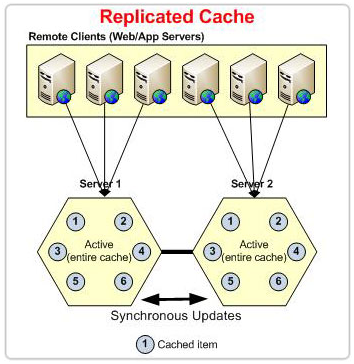| < Previous page | Next page > |
Replicated Cache
Multiple Server Nodes: In replicated cache, there can be two or more server nodes. Each node is replica of the cache, i.e., all server nodes contain the same set of cached data.
More than One Backups: It has more than one backup of the cached data. With an increase of server nodes in cluster, the number of backups also increase.
Replication Mode: Replications are performed synchronously on all other nodes of the cache. In synchronous parallel replication, there is a chance that two parallel requests for updating the same data may result in different state on different replica nodes. But using a global token performs updates on all nodes in a sequenced fashion to avoid data integrity issues.
Clients Load Balancing: Cache clients are load balanced automatically by the cluster for an even distribution of load
on the cache nodes. This ensures that any one node is not overwhelmed by the cache client requests. Client load balancing is configurable and can be turned off.
High Performance in Reference Data: Replicated cache is suitable when data read are more than data writes. For any cache client, reads are local to the server which means that cache client have direct access to all data.
Runtime Scalability: Server nodes can be added or removed in replicated cache like other topologies at run time.
Low Performance in Transactional Data: As more server nodes are added to scale the replicated cache, write overhead increases. So this topology is not suitable for applications having transactional type of data.
Storage Limitation to Each Server Node: Adding more nodes does not increase the storage capacity because every node has same data set.
High Availability: Replicated topology is best for applications where high availability and reliability with zero down time is the priority. This is because this topology contains multiple backups of cached data set.
State Transfer: Every server node replicates the state from the coordinator node (the senior most node in terms of cluster joining) when it joins the cache cluster.

See Also
|